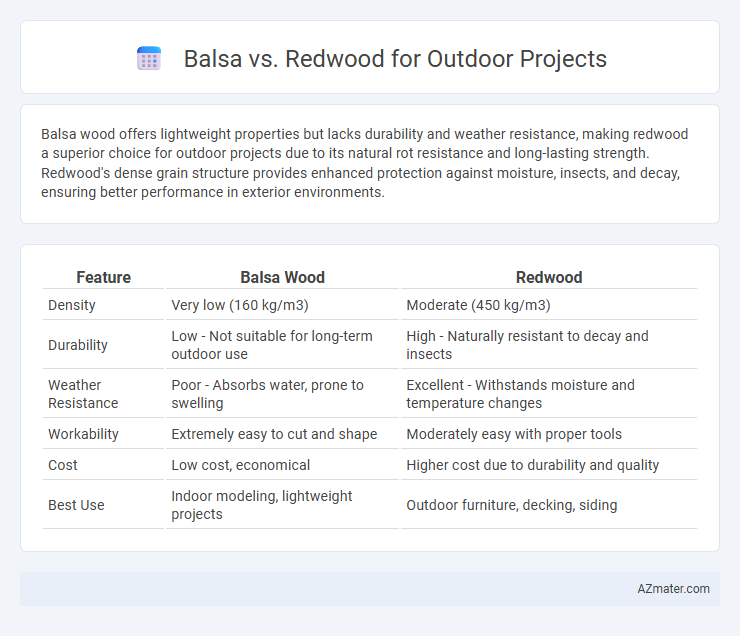Balsa wood offers lightweight properties but lacks durability and weather resistance, making redwood a superior choice for outdoor projects due to its natural rot resistance and long-lasting strength. Redwood's dense grain structure provides enhanced protection against moisture, insects, and decay, ensuring better performance in exterior environments.
Table of Comparison
| Feature | Balsa Wood | Redwood |
|---|---|---|
| Density | Very low (160 kg/m3) | Moderate (450 kg/m3) |
| Durability | Low - Not suitable for long-term outdoor use | High - Naturally resistant to decay and insects |
| Weather Resistance | Poor - Absorbs water, prone to swelling | Excellent - Withstands moisture and temperature changes |
| Workability | Extremely easy to cut and shape | Moderately easy with proper tools |
| Cost | Low cost, economical | Higher cost due to durability and quality |
| Best Use | Indoor modeling, lightweight projects | Outdoor furniture, decking, siding |
Introduction to Balsa and Redwood
Balsa and redwood are popular materials for outdoor projects, each offering distinct characteristics suited to different needs. Balsa wood is lightweight, soft, and easy to shape, making it ideal for intricate models and lightweight structures, but it lacks natural resistance to moisture and decay. Redwood, known for its rich color and durability, possesses natural oils that protect against rot and insect damage, making it a superior choice for long-lasting outdoor applications such as decks, fences, and garden furniture.
Key Differences Between Balsa and Redwood
Balsa wood is extremely lightweight and soft, making it unsuitable for heavy outdoor projects, while redwood is dense, durable, and naturally resistant to decay and insects, ideal for outdoor applications. Redwood's rich reddish color and grain add aesthetic value, whereas balsa is pale and lacks the natural oils that provide weather resistance. Cost-wise, balsa is cheaper but less durable, whereas redwood commands a higher price due to its longevity and strength in outdoor environments.
Durability in Outdoor Conditions
Redwood offers superior durability in outdoor conditions due to its natural resistance to moisture, decay, and insect damage, making it ideal for long-lasting outdoor projects. Balsa, while lightweight and easy to work with, lacks the density and protective oils that enhance resistance to weathering and therefore requires additional treatment or sealing for extended outdoor use. Choosing redwood ensures longevity and lower maintenance in outdoor environments compared to untreated balsa wood.
Weight and Workability Comparison
Balsa wood is significantly lighter than redwood, making it ideal for projects where weight reduction is crucial, such as model building or lightweight outdoor furniture. Redwood, while heavier, offers greater durability and natural resistance to decay, essential for long-lasting outdoor structures. Both woods boast excellent workability, but balsa's softness allows easier cutting and shaping, whereas redwood requires more effort due to its denser grain texture.
Weather Resistance and Longevity
Redwood offers superior weather resistance compared to balsa, thanks to its natural oils that protect against moisture, decay, and insect damage, making it ideal for outdoor projects exposed to harsh elements. Balsa, while lightweight and easy to work with, lacks durability and is prone to water absorption and rot, significantly reducing its longevity in outdoor conditions. Choosing redwood ensures a longer-lasting outdoor structure with minimal maintenance, whereas balsa is better suited for indoor or temporary applications.
Cost Analysis: Balsa vs Redwood
Balsa wood is significantly more affordable than redwood, making it a cost-effective choice for outdoor projects with budget constraints. Redwood, while more expensive, offers superior natural resistance to decay and insects, potentially lowering long-term maintenance costs. Evaluating initial material costs against durability and upkeep reveals that balsa suits short-term projects, whereas redwood provides better value for longevity.
Aesthetic Appeal for Outdoor Projects
Balsa wood offers a light, pale color with a soft texture that can lend a natural, rustic charm to outdoor projects but tends to weather quickly without protective finishes. Redwood boasts a rich, deep reddish hue with tight grain patterns that enhance the visual warmth and elegance of decks or furniture while providing superior resistance to moisture and decay. The choice between balsa and redwood depends on whether the project prioritizes lightweight aesthetics or durable, long-lasting beauty in an outdoor environment.
Environmental Impact and Sustainability
Balsa wood, known for its rapid growth and renewable properties, offers a lower environmental impact compared to slow-growing redwood, which requires longer harvesting cycles and contributes to deforestation risks. Redwood provides natural resistance to decay and pests, reducing the need for chemical treatments that can harm ecosystems, yet its limited availability raises sustainability concerns. Choosing balsa supports faster forest regeneration, while redwood's durability can extend project lifespan, both factors influencing the overall ecological footprint of outdoor projects.
Best Uses for Balsa and Redwood Outdoors
Balsa wood, known for its lightweight and soft texture, is best suited for indoor or protected outdoor projects such as model making, lightweight crafts, and temporary garden decorations where minimal exposure to moisture occurs. Redwood's natural resistance to rot, decay, and insects makes it ideal for long-lasting outdoor applications like decks, fences, garden furniture, and siding that require durability in various weather conditions. Choosing redwood for moisture-prone outdoor environments ensures structural stability and reduces maintenance, whereas balsa is preferable for projects needing easy shaping and low weight rather than weather resistance.
Final Recommendations: Choosing the Right Wood
Balsa wood offers lightweight and ease of work ideal for small-scale outdoor models, but its low durability and softness limit its use in long-term outdoor projects. Redwood provides superior resistance to decay and insects, making it a preferred choice for decks, fences, and outdoor furniture where strength and longevity are essential. For projects requiring durability and weather resistance, redwood is recommended, while balsa suits temporary, lightweight applications.

Infographic: Balsa vs Redwood for Outdoor Project
 azmater.com
azmater.com